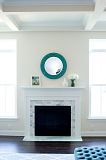It is hard to believe, but we have lived in our present house for ten years this July. When we moved in, the backyard was empty - our own personal prairie grassland. A dead bush that looked like a tumbleweed blew down our street one day so I put it in the backyard to help complete the look. If we were going to have a prairie in our backyard then we should at least have a tumbleweed.
 |
| Our backyard (June 2011) |
The spring after we moved in we bought a wooden climber from a friend. The climber was a big hit and was used continuously for years. Sadly those days are gone, although the climber is still there hidden by the bushes and trees. A couple of years after we got the climber another friend gave us their heavy-duty swing set, which originally had two children's swings on it, but now has our garden swing.
 |
Backyard in the same view as the first photo (spring 2002). The wood in the back right corner is the soon to be climber.
|
 |
| Rear of the house (spring 2002). Note the "tumbleweed" against the fence on the left. |
It seemed very daunting to create a beautiful, useful, fun space out of our bleak barren backyard. How were we going to make an impact there without spending a fortune? We needed some shade stat, but how were we going to accomplish that without bringing in mature trees. I looked in my garden books and on-line for some advice and there was surprisingly little information out there about how to make a bare subdivision yard look nice as quickly as possible without spending a fortune.
So these are some of the best tips I discovered and they were very helpful to me so I'm passing them along to anyone else faced with a bare backyard.
Tip #1 - Look at where your neighbours have trees and line yours up on the same side. It seemed counterintuitive, because you would think you should spread the trees around, but what it does is give you a sight line of greenery and makes your yard seemer greener faster. This is the view we have out our dining room garden doors so I love that it is a wall of greenery.
 |
| A swath of greenery created by planting trees and bushes on our side of the fence to fill out in front of our neighbour's tree. |
 |
| The extra height gained by planting our garden under our neighbour's roses (which you can see above and growing through the fence) helps create a more mature looking garden. |
Tip #2 - Plant some fast-growing trees and bushes as well as some long-term ones. Bushes and trees like pussy willows are not usually featured in garden plans that you see in magazines and books, but they definitely serve a valuable place in a new garden. You want a mix of fast-growing and long-term plants so that you get some immediate shade, but in 20 years or so when the fast-growing plants are finished your long-term trees and bushes are ready to take over.
 |
| The willow just past the swing has grown from a twig to a sizable bush in about eight years and casts a nice area of shade. |
Tip # 3 - You want to make the garden beds wide enough and with nice gently curved edges so that they look interesting. Even garden beds along a fence, unless you are making a really formal or modern garden, look better with some curves to them. A great tip I read was to use a garden hose to mark the shape of the new garden beds. The hose doesn't bend easily so will only create undulating beds with a nice gentle curve. Lay the hose along the edge of where you envision your garden should be until you are satisfied with its shape and then cut the sod there.
 |
Newly built flower beds (July 2003)
|
 |
| Back garden beds (June 2010) |
We had one flower bed that was a rectangle about seven feet long and three feet wide. This is not a good dimension for a garden as it rather looked like we had just buried someone back there. We referred to if fondly as our coffin garden. To fix this problem we widened the bed slightly and rounded one end incorporating a couple of bushes so there was some height making it more interesting and less graveyardish.
By making the garden beds a minimum of three feet wide, but hopefully more like four or five feet, you create a space wide enough that you can plant bushes away from the fence. Nothing looks worse in a few years to see mature bushes all misshapen because they were planted too close to the fence. The wider garden beds also allow plants to be layered in front of one another to make a more interesting arrangement.
Anyone else have some tried and true garden tips for the new home gardeners out there?
 Linked to Wow us Wednesday at Savvy Southern Style
Linked to Wow us Wednesday at Savvy Southern Style




,+lighthouse+paint+chip+001.jpg)
,+lighthouse+paint+chip+006.jpg)

,+lighthouse+paint+chip+029.jpg)
,+lighthouse+paint+chip+035.jpg)
,+lighthouse+paint+chip+025.jpg)
,+lighthouse+paint+chip+040.jpg)
,+lighthouse+paint+chip+043.jpg)















































































































































































































.jpg)



















































































.jpg)


























